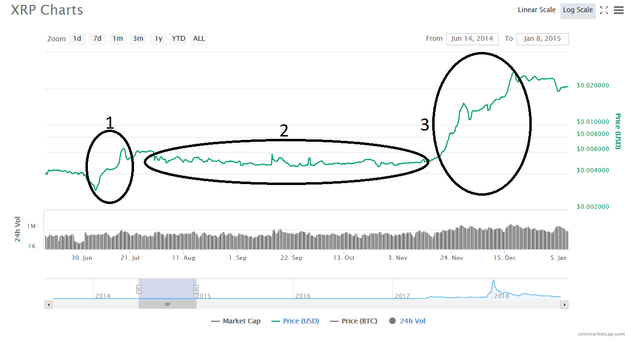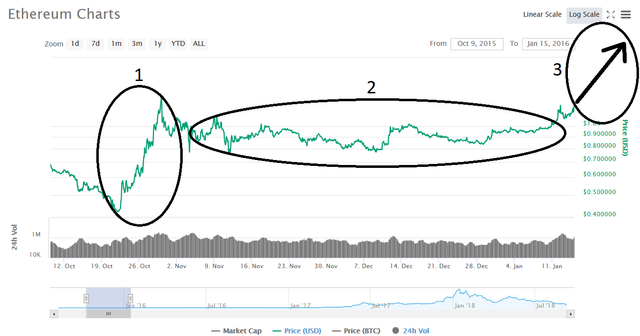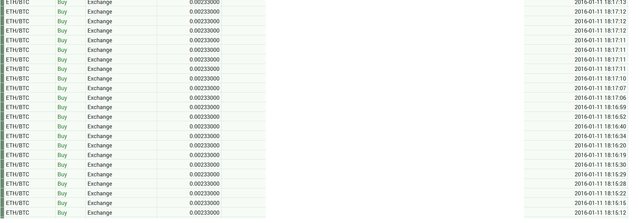What it is Really Like Buying ETH for $1
It’s not what is seems. I would be surprised if anybody simply buys at $1 and sells at $1000, or, better yet, sell at the possible future $10,000 mark or beyond.
I became an early adopter/investor in bitcoin back in mid-late 2012. Around mid-late 2015, I began paying attention to crypto projects other than bitcoin as it became increasingly likely that bitcoin would not scale. Also, Proof of Stake (POS) was a plausible candidate to supersede the energy-hog POW consensus mechanism. General anecdotal sentiment at the time was mostly horrible; i.e., how dare another scamcoin challenge bitcoin. It will surely fail. So, from a contrarian point of view, ETH was ripe for a rally.
Ethereum was touted as a turing complete, open platform for not only money, but essentially all things financial. It looked to be the natural progression and advancement of consensus-driven technology, taking the ecosystem to the next level. However, Ethereum was not alone. Bitshares, NXT and a few others were strong competitors to Ethereum at the time, all of which I put money into with varying degrees of failure and success.
ETH began trading in mid-2015 and quickly declined, losing over 2/3rds of its value, falling from nearly $1.50 to below $0.50. I had done a bit of buying during this time, feeling stupid as each new purchase saw another sharp drop in price, as is the typical market participant’s experience in a bear market. In late October of 2015, a massive rally took place in a few short days, causing ETH to more than triple in price, and subsequently settle in a range from roughly $0.80 to $1.00 over the next couple of months. I did some nibbling in this area, but no major purchases. As the first of the year approached I noticed a familiar fractal pattern emerging in the price. I had seen this fractal before in Ripple XRP. XRP had a sharp leg up in June of 2014 and formed a consolidation range into November of that year with a support base of roughly $0.0045. An even stronger leg up occurred into mid-December of 2014, third-wave style for those Elliot wave technicians out there. ETH appeared to be poised for a third-wave style rise based on a similar chart pattern depicted in the images below.

coinmarketcap.com

coinmarketcap.com
I had missed the XRP rally in 2014 and FOMO’d in after the rally was over, only to watch prices collapse, causing me to lose money. Lesson learned. This time I needed a plan to reduce risk as much as possible and build a long-term position, as staking was in the Ethereum roadmap, allowing investors to earn a return on investment. I knew there was a possibility for prices to increase by several multiples, just as XRP had done in the Nov-Dec 2014 rally, so there was a chance to get a stack of ETH, essentially for free, if I played my cards right. Ultimately, my analysis showed that this could be a trillion-dollar chain, which meant prices could eventually reach upwards of $10,000. The long-term position was essential.
My strategy was to continue to buy incrementally (mostly to calm my FOMO) and make a significant purchase on the breakout if it happened. I had no stops. I only invested what I was willing to lose 100% of if ETH went to 0. Finally, on Jan 11th 2016, the breakout appeared to be happening and I did my heavy buying. My average entry point was close to $1.00, if not a bit below over the course of a few months.

Fortunately, prices continued to rise.
I don’t remember the exact details, but my actions went essentially like this: I sold about 20% at around $1.15 because, well, I had just gotten a 15% gain in a day or two. That beats the average annual returns of the stock market, so might as well sell some to reduce my cost basis, if for no other reason than to feel better about this investment. I at least needed to have a sense of winning to calm my nerves. I Sold another 20% or so at around $1.35, more at $1.65, and even more at $1.95. After each sell I put in a bid to rebuy at the previous support level. Only one of those bids got hit. I had about 50% of my stack left once prices got to $2.00.
The bulk of that rally lasted for about 3 months into March, with prices reaching above $15, and eventually above $21 in June of 2016 on most exchanges. By that time, I was down to holding only my long-term position, which was less than 2% of my original stack. That was ok because I was now playing with house money and I had plenty of profits to buy back in if prices declined. At that point, the DOA hack triggered a selloff and a 6-month, 60%+ decline in prices, so I was fortunate enough to buy (at least somewhat) back in.
I got back in to about 30% of my original stack by the end of that ensuing correction phase, which went into December of 2016. At this point, it was fairly obvious that bitcoin wasn’t going to meaningfully scale, and something else was the better bet. ETH was still that better bet. In analyzing the markets, I concluded that a rally could take place within the next couple of years. The market cap for the entire space sat at just under $20 billion at the time (just above the ATH), so I figured a bubble could possibly reach $100 billion, which I thought was reasonable for that fundamental stage of the technology. The previous bitcoin bubble of 2013 had surpassed the 2011 bubble high by roughly a factor of 8, so my thoughts were that the 2017 crypto bubble could surpass the previous bubble high by a factor of maybe 5, keeping with a Fibonacci sequence based on an exponential logarithmic curve in price action. That analysis was wrong. Prices rose by about a factor of 60 above the previous ATH.
Consequently, I ended up selling most of my stack by the time prices hit $100. As prices reached $100, I was nearly certain that I would be able to buy back lower, so I sold most of my stack, took the proceeds, and planned on buying back at price points from $60 on down. Those prices were never reached again, and the bubble ended with a total market capitalization of the crypto space at just short of $1 trillion and with an ETH price of over $1400.
The takeaway here is that I was down to about 3.33% of my original stack at a price point of $100. I was convinced that the top of the bubble was imminent at that point. However, I was wrong. Prices subsequently exploded to over $1400. If Ethereum truly is viable long term, which I think it is, then I won’t ever get a chance to buy back below $100. This is perfectly fine with me, for I made good on Warren Buffet’s two rules: Rule #1) Don’t lose money, and Rule #2) Don’t forget rule number 1. Would I like to still have 100% of my original stack? Of course. Is that realistic? Of course NOT. If I had it to do all over again, I would probably do the same thing.
Going forward, I mostly agree with Vitalik Buterin that the days of 1000x gains are essentially over. I believe this is true for most of the major chains out there. However, the possibility exists that 100x gains could occur for a select few assets in the next bubble (if it happens), most likely native tokens of protocols that exist on top of base-layer protocols. These types of gains will likely be much fewer and far between and extremely difficult to pick.
My strategy, which has not changed for quite some time, is to own native assets of open-ended, base-layer, consensus-driven financial protocols (blockchains). These protocols need to be Proof-of-Stake(POS)-based unless a superior consensus mechanism emerges. I am currently looking into hashgraph but it would likely have to be significantly better on multiple levels to oust the incumbents, so I am taking it with a grain of salt. I have already assembled a nice basket of POS-based assets and I actively stake (or delegate) on some chains currently. Several solid projects exist at this point. Ethereum is the front-runner for now.
For what it is worth, I think the 2000-Nasdaq-ish bubble is still in the offing.
Disclaimer: None of this is advice of any kind.
Exceptional story man. We have to learn from your experience...
May I ask you which PoS mainly you own now?
Is CARDANO one of them?
Yes. Ethereum, EOS, and Cardano are my top three.
Thank you for great story, so much to learn from!
Posted using Partiko Android
where are u hiding man. looking forward to your next article!